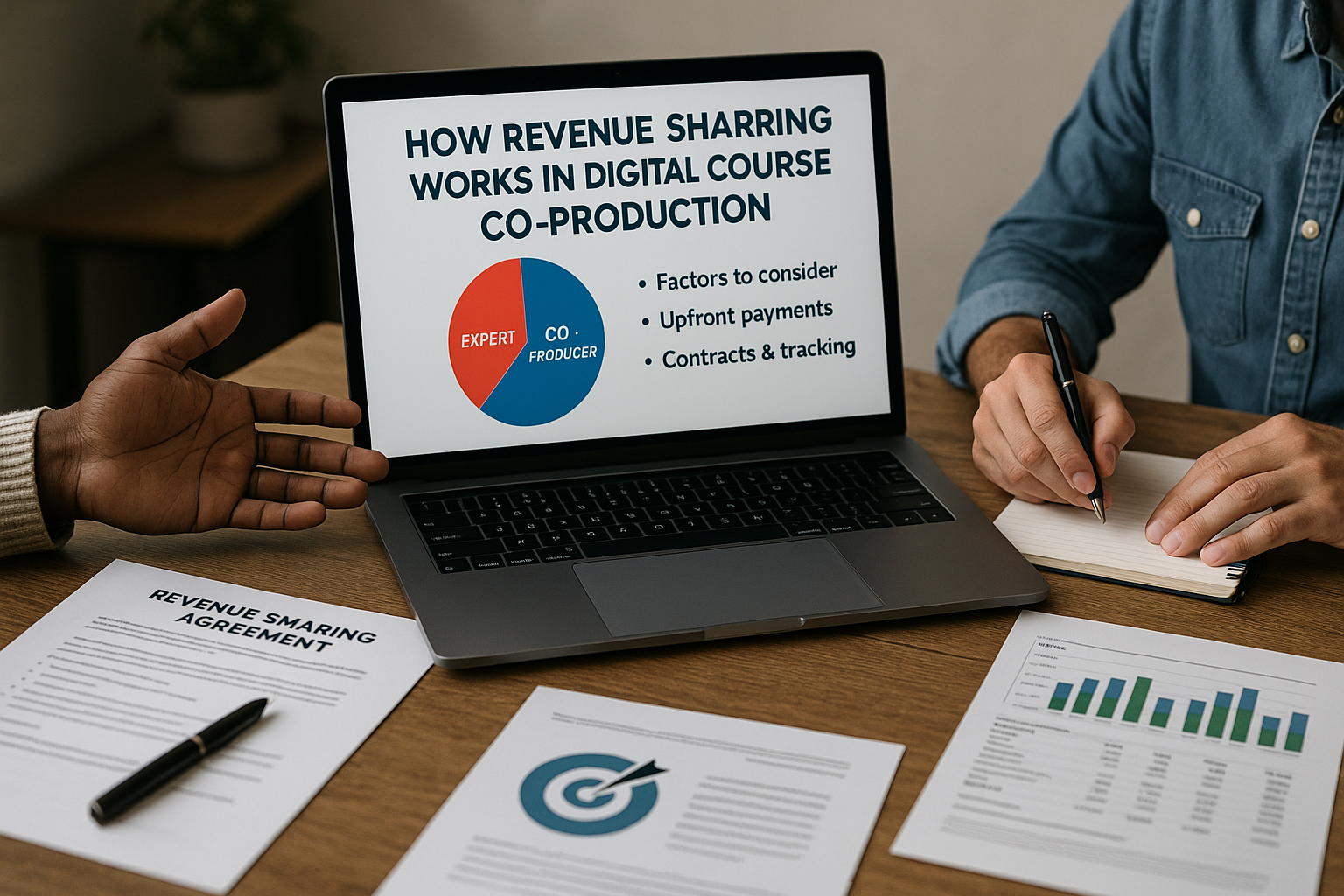One of the most important — and sometimes confusing — parts of digital course co-production is figuring out how the money is split between partners. If you’re new to this world, you might be wondering:
- How do co-producers make money?
- What percentage should each party receive?
- What happens when more people are involved?
In this article, we’ll break down exactly how revenue sharing works in co-produced digital courses, with real-world examples, models, and practical tips to help you negotiate fair and profitable deals.
What Is Revenue Sharing?
Revenue sharing is an agreement between partners that defines how the total earnings from a product are divided. In co-production, this typically includes the:
- Expert or specialist (who teaches the course)
- Co-producer or project lead (who plans and executes the launch)
Sometimes, there are additional roles such as media editors, ad managers, copywriters, or affiliates — all of whom may also receive a percentage of the revenue.
The Most Common Revenue Split: 50/50
In many co-productions, the most common arrangement is a 50/50 split between the expert and the co-producer.
Why?
- The expert brings the knowledge, trust, and content.
- The co-producer brings the structure, audience, and conversion.
This setup recognizes both parties equally and works especially well when:
- The course is being created from scratch
- The expert does not have a large existing audience
- The co-producer is leading strategy, marketing, and tech
Other Revenue Split Scenarios
While 50/50 is popular, it’s not the only model. Here are some other options depending on the situation:
1. 70/30 in Favor of the Expert
✅ When the expert already has a large, engaged audience
✅ When the co-producer has a more limited role (e.g., tech only)
Example:
- Expert: 70%
- Co-producer: 30%
2. 60/40 in Favor of the Co-Producer
✅ When the co-producer is doing most of the heavy lifting, including:
- Building the product
- Managing ads
- Leading the funnel and team
Example:
- Co-producer: 60%
- Expert: 40%
3. Multi-Partner Model
In larger teams, percentages are split among several members.
Example (Team of 4):
- Expert: 40%
- Co-producer/strategist: 30%
- Media buyer: 15%
- Copywriter: 15%
This model works well for high-ticket launches or when roles are highly specialized.
How to Define a Fair Split
Here are a few factors to consider when negotiating revenue sharing:
🧠 Expertise and Experience
Is the expert a well-known figure with proven authority? Then a higher share might be justified.
🎯 Workload and Responsibility
Who’s doing the majority of the work? If you’re building the funnel, managing the team, and running the ads, your role should be compensated accordingly.
💬 Audience Size
If the expert already has a large list, following, or community, they may contribute more leads, and that can impact the split.
🛠 Investment in Tools or Ads
If one party is paying for ads, software, or production, those costs should be reimbursed first or accounted for in the split.
Should You Pay or Get Paid Up Front?
Most co-production deals are revenue share only, meaning no one is paid upfront. Instead, the team earns based on results.
However, in some cases, especially if the project is complex or the co-producer is hired more like a consultant, a hybrid model is used:
- A small upfront fee (e.g., $1,000 for setup)
- Plus a smaller revenue percentage (e.g., 30%)
This ensures commitment while keeping everyone motivated to succeed.
What About Recurring Revenue or Evergreen Courses?
If the course will be sold in perpetual/evergreen mode (i.e., always available), revenue splits should include:
- How often payments will be made (monthly, quarterly)
- Who tracks sales and sends reports
- What happens if one partner leaves
In recurring models, it’s common to reduce the co-producer’s percentage slightly over time (e.g., 50% for 12 months, 30% for the second year), but this must be agreed upon in writing.
How to Track and Pay Earnings
To avoid misunderstandings, have a system in place to:
- Track total revenue (via platforms like Hotmart, Teachable, or Stripe)
- Deduct fees (platform commissions, ad spend, taxes)
- Distribute net revenue according to agreed percentages
- Provide monthly or quarterly reporting
💡 Tip: Use tools like Google Sheets, Notion, or Profitwell to automate part of this.
Always Use a Written Agreement
A revenue sharing deal should never be verbal or casual — even if it’s with a friend.
A simple contract should include:
- Partner names and roles
- Revenue share percentages
- Duration of agreement
- Payment frequency and method
- What happens in case of conflict or exit
If needed, consult a lawyer or use legal templates tailored for co-productions.
What If the Launch Doesn’t Make Money?
Unfortunately, not every course launch is a hit. If a project earns less than expected — or nothing at all — revenue share means no one gets paid unless there’s a sale.
That’s why it’s important to:
- Vet your expert carefully
- Test the offer before launching
- Start with a minimum viable product (MVP)
- Learn from feedback and iterate quickly
Co-production is a business — and every business comes with some level of risk.
Final Thoughts: Win Together, Learn Together
The beauty of co-production is that both sides win together — but this only works with clarity, fairness, and transparency.
Revenue sharing should feel empowering, not stressful. It’s about creating an agreement where everyone is motivated to succeed — not just for a single launch, but for the long term.
Choose your partners wisely, keep things transparent, and build relationships based on value — not just numbers.

